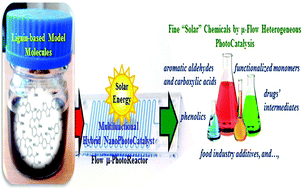当前位置:
X-MOL 学术
›
Chem. Soc. Rev.
›
论文详情
Our official English website, www.x-mol.net, welcomes your
feedback! (Note: you will need to create a separate account there.)
Selective photocatalysis of lignin-inspired chemicals by integrating hybrid nanocatalysis in microfluidic reactors
Chemical Society Reviews ( IF 40.4 ) Pub Date : 2017-10-16 00:00:00 , DOI: 10.1039/c7cs00257b Juan Carlos Colmenares 1, 2, 3, 4 , Rajender S. Varma 5, 6, 7, 8, 9 , Vaishakh Nair 1, 2, 3, 4
Chemical Society Reviews ( IF 40.4 ) Pub Date : 2017-10-16 00:00:00 , DOI: 10.1039/c7cs00257b Juan Carlos Colmenares 1, 2, 3, 4 , Rajender S. Varma 5, 6, 7, 8, 9 , Vaishakh Nair 1, 2, 3, 4
Affiliation

|
This tutorial review assesses the available and possible strategies for attaining higher selectivity and yield of value-added chemicals from lignin using nanocatalysts embedded in a photomicroreactor. The design of the photomicroreactor, the choice of photocatalysts and the techniques for assembling the catalysts in such confined spaces are crucial elements. Lignin, a predominant industrial byproduct and pollutant, has been recognized today as a rich reservoir for aromatic chemicals and a prominent resource. The conventional batch photocatalytic studies on lignin, often using dissolved lignin under alkaline conditions, often generates a wide range of valuable organic chemicals which find applications in the pharmaceutical, food processing, cosmetic and fine chemical industries. The role of photocatalysis in such lignin depolymerizations is questionable as the dissolution procedure initiates fragmentation of lignin prior to light exposure. The complexity of the lignin structure also impedes necessary and decisive information to understand the reaction mechanism during such reactions in batch photoreactors. Considering these facts, photocatalysis studies on lignin entail a thoughtful reevaluation and focus on understanding the role of photocatalysis in the product generation and authenticating the implicated reaction mechanisms. The development of a photocatalytic system for lignin depolymerization in a continuous microreactor is a superior approach for the generation of valuable products emanating from lignin depolymerization and the successful execution of such strategies can pave the way for the commercialization of bio-based chemicals.
中文翻译:

通过在微流控反应器中整合杂化纳米催化选择性地催化木质素启发的化学物质
本教程概述评估了使用嵌入在光微反应器中的纳米催化剂从木质素获得更高的选择性和产率的增值化学品的可用和可能的策略。光微反应器的设计,光催化剂的选择以及在这样的狭窄空间中组装催化剂的技术是至关重要的要素。木质素是主要的工业副产品和污染物,如今已被认为是丰富的芳香族化学品和重要资源的仓库。木质素的常规分批光催化研究通常在碱性条件下使用溶解的木质素,通常会产生多种有价值的有机化学物质,这些有机化学物质可用于制药,食品加工,化妆品和精细化工行业。在这种木质素解聚反应中,光催化的作用值得怀疑,因为溶解过程会在曝光前引发木质素的断裂。木质素结构的复杂性也阻碍了必要的和决定性的信息来理解间歇式光反应器中此类反应过程中的反应机理。考虑到这些事实,对木质素的光催化研究需要进行深思熟虑的重新评估,并着重于理解光催化在产物产生中的作用并验证所涉及的反应机理。
更新日期:2017-11-13
中文翻译:

通过在微流控反应器中整合杂化纳米催化选择性地催化木质素启发的化学物质
本教程概述评估了使用嵌入在光微反应器中的纳米催化剂从木质素获得更高的选择性和产率的增值化学品的可用和可能的策略。光微反应器的设计,光催化剂的选择以及在这样的狭窄空间中组装催化剂的技术是至关重要的要素。木质素是主要的工业副产品和污染物,如今已被认为是丰富的芳香族化学品和重要资源的仓库。木质素的常规分批光催化研究通常在碱性条件下使用溶解的木质素,通常会产生多种有价值的有机化学物质,这些有机化学物质可用于制药,食品加工,化妆品和精细化工行业。在这种木质素解聚反应中,光催化的作用值得怀疑,因为溶解过程会在曝光前引发木质素的断裂。木质素结构的复杂性也阻碍了必要的和决定性的信息来理解间歇式光反应器中此类反应过程中的反应机理。考虑到这些事实,对木质素的光催化研究需要进行深思熟虑的重新评估,并着重于理解光催化在产物产生中的作用并验证所涉及的反应机理。











































 京公网安备 11010802027423号
京公网安备 11010802027423号